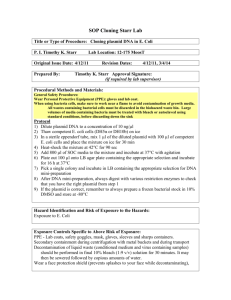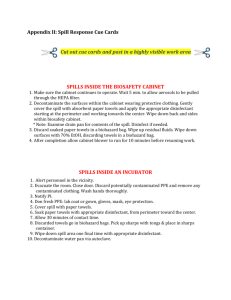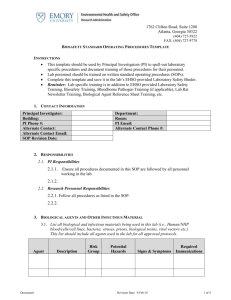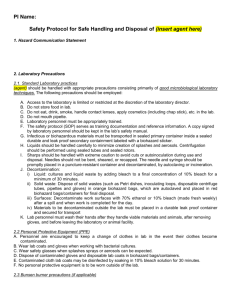Biology BSL2 protocols - American University of Beirut
advertisement
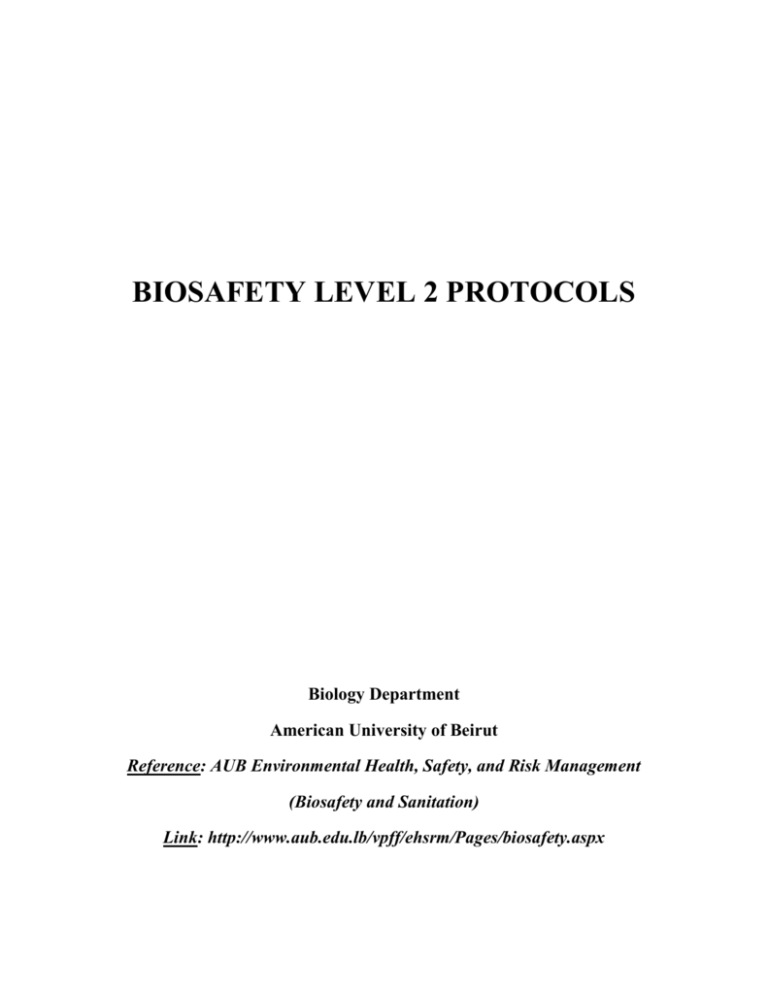
BIOSAFETY LEVEL 2 PROTOCOLS Biology Department American University of Beirut Reference: AUB Environmental Health, Safety, and Risk Management (Biosafety and Sanitation) Link: http://www.aub.edu.lb/vpff/ehsrm/Pages/biosafety.aspx Principles of Biosafety A fundamental objective of any biosafety program is the containment of potentially harmful biological agents. The term “containment” is used in describing safe methods, facilities and equipment for managing infectious materials in the laboratory environment where they are being handled or maintained. The purpose of containment is to reduce or eliminate exposure of laboratory workers, other persons, and the outside environment to potentially hazardous agents. The use of vaccines may provide an increased level of personal protection. The risk assessment of the work to be done with a specific agent will determine the appropriate combination of these elements. Biosafety Level 1 (BSL-1) Suitable for work involving well-characterized agents not known to consistently cause disease in immunocompetent adult humans, and present minimal potential hazard to laboratory personnel and the environment. BSL-1 laboratories are not necessarily separated from the general traffic patterns in the building. Work is typically conducted on open bench tops using standard microbiological practices. Special containment equipment or facility design is not required, but may be used as determined by appropriate risk assessment. Laboratory personnel must have specific training in the procedures conducted in the laboratory and must be supervised by the training scientist. Biosafety Level 2 (BSL-2) Suitable for work involving agents that pose moderate hazards to personnel and the environment. It differs fro BSL-1 in that: 1) Laboratory personnel have specific training in handling pathogenic agents and are supervised by scientists competent in handling infectious agents and associated procedures. 2) Access to the laboratory is restricted when work is being conducted. 3) All procedures in which infectious aerosols or splashes may be created are conducted in Biosafety Cabinets (BSCs) or other physical containment equipment. Laboratory Practice and Technique The most important element of containment is strict adherence to standard microbiological practices and techniques. Persons working with infectious agents or potentially infected materials must be aware of potential hazards, and must be trained and proficient in the practice and techniques required for handling such material safely. General and BSL2 measures - Consult the material safety data sheets of the pathogenic agents to be manipulated before starting the work. - Access to laboratory is limited to authorized personnel. - Personal items such as purses and outdoor clothing should be kept outside the room. - Keep laboratory door closed at all times. - Eating, drinking, smoking, storing of either food, personal belongings, or utensils is not permitted in the laboratory. - Applying cosmetics, and inserting or removing contact lenses is not permitted in the laboratory. - Wearing jewellery is not permitted and long hair is to be tied back or restrained so that it cannot come into contact with hands, specimens, containers or equipment. - Protective laboratory coats, gowns, smocks, or uniforms designated for laboratory use must be worn while working with hazardous materials. Remove protective clothing before leaving for non-laboratory areas. - Suitable footwear with closed toes and heels must be worn in all laboratory areas. - Wearing protective eye glasses and face shields (goggles) if necessary to guard the eyes and face against risks of liquid projections and objects’ impact whether during routine operations or in exceptional cases. - Do not mouth pipette. Always use mechanical pipetting devices. - If a known or suspected exposure occurs, contaminated clothing must be decontaminated before laundering. - -Do not bend, break, or recap needles. Dispose of needles in puncture-resistant containers. - Hands must be washed 1) on entering the laboratory, 2) after gloves have been removed, 3) before leaving the laboratory and 4) at any time after handling materials known or suspected to be contaminated. - The laboratory is to be kept clean and tidy. - Use of biological safety cabinet or other physical containment devices for procedures involving the manipulation of infectious materials that may generate an aerosol. - Disinfectants effective and appropriate against the agents handled must be available at all times in the laboratory and used for decontaminating all surfaces and materials. - Decontaminate work surfaces and equipment routinely, after completion of work and immediately after a spill or splash. - Decontaminate other contaminated materials before washing, reuse, or discard. - Place potentially infectious materials in a durable, leak proof container during collection, handling, processing, storage or transport within a facility. For off-site decontamination, package contaminated materials in durable, leak proof containers and secured for transport. - Accidents of exposures to infectious materials and losses of containment must be reported immediately to the laboratory supervisor. - Remove broken glass using a brush and dustpan, tongs, or forceps. - Wash hands after working with potentially hazardous materials, after removing gloves and before leaving laboratory. - Perform all procedures to minimize the creation of splashes and/or aerosols. - Post biohazard symbols at lab entrance and on equipment where infectious agents are used/stored. - Keep animals and plants not associated with the work performed out of the laboratory. - An effective integrated pest management program is required. Biological Safety Cabinets (BSC) Introduction Biological Safety Cabinets, (BSCs), also known as tissue culture hoods, are designed to provide personnel, environmental and product protection when appropriate practices and procedures are followed. A BSC is an enclosed, ventilated laboratory workspace for safely working with materials contaminated with (or potentially contaminated with) pathogens requiring a defined biosafety level. THE CLASS II BSCS Class II BSCs rely on directional movement of air to provide containment. Airflow is drawn into the front grille of the cabinet, providing personnel protection. The most commonly used BSC is a Class II A2. The A2 recirculates 70% of air and is not suitable for volatile solvents or isotope usage. Use of Biological Safety Cabinets - Do not use the UV lights of the BSC. - Before using the BSC 1) place the sash in the appropriate position 2) check the air intake and exhaust grilles for obstructions 3) confirm inward airflow either by checking the counters or by holding a tissue at the middle of the edge of the viewing panel and ensuring that it is drawn in 4) disinfect the interior surfaces with a suitable, noncorrosive disinfectant. - During handling inside the BSC 1) avoid excessive movement of hands and arms through the front access opening 2) ensure not to obstruct the air grilles 3) keep discarded, contaminated material to the rear of the cabinet separated from sterile “clean” solutions and instruments 4) perform operations as far to the rear of the work area as possible 5) avoid performing operations over the biological material 6) ensure to discard wastes in containers inside of the BSC (sharp objects such as pipettes should be placed in a secure container) - Do not work with open flames inside the BSC. - At the end of BSC use 1) allow the BSC to function for 5 minutes, 2) close or cover open containers before removing them from the BSC 3) surface disinfect objects in contact with contaminated material before removing them from the BSC .Disinfect the working surfaces while the BSC is in run. Decontaminate the contaminated or potentially contaminated surfaces with a disinfectant appropriate for the pathogenic agent in concern, such as a solution of ethyl alcohol or isopropyl alcohol 70% (cells, retroviruses, and influenza. Leave the surface in contact with the solution for 10 minutes before rinsing and wiping. 4) remove the gloves and dispose of them inside the BSC 5) ensure that all biological materials are disposed safely Proper use of BSC link: http://www.youtube.com/watch?v=ZnUW1N-JJz8 Cleaning BSC http://www.youtube.com/watch?v=NgQxOwcOXE0&feature=related Decontamination and Elimination of Biological Wastes Liquid Waste Disinfecting BSL1 and BSL2 liquid biohazardous waste is required prior to drain disposal. Chemical disinfection Liquid should be collected in a leak proof plastic or glass container, with tight lids, labeled by the word & symbol BIOHAZARD. Chemical disinfection should be conducted using an approved chemical disinfectant for the appropriate contact time, e.g. add 10ml of Sodium Hypochlorite (Bleach) for every 100ml of the liquid waste and allow for a contact time of 20-30 minutes (1:10 v/v dilution). The MSDS of the disinfectant used should be available and shared with the users. Proper personal protective equipment shall be used (e.g. lab coat, gloves and eye protection). After the required contact time, the disinfected liquid waste should be carefully poured down the sink and the drain flushed with a copious amount of water. N.B: Tightly closed tubes/containers containing small quantities of biohazardous liquids (less than 10 ml) can be discarded in the yellow biohazardous waste bags. Solid Waste Biohazardous wastes are wastes which are capable of producing infectious diseases. - Biohazardous waste should be sorted at the site of generation into color-coded approved plastic bags or containers. - Waste bags should be placed in an approved secondary plastic container. - Bags and containers should be labeled by the biohazard symbol and the word “BIOHAZARDOUS WASTE” in Arabic and English, and should not be filled more than ¾ of their loading capacity. - See diagram below which demonstrates the segregation of different types of solid biohazardous wastes. Biohazardous waste in yellow bags will be picked up ad transferred to AUBMC for autoclaving every Monday and Friday morning. Biological Spill Response Procedures Laboratories that are handling infectious agents must develop spill response plans addressing foreseeable occurrences. Biological Spill Kit with items to clean and/or contain a biological spill must be placed in a designated location inside the lab, all personnel must know of the location. At a minimum, the spill kit should contain: Gloves (appropriately sized and within expiration date). Eye Protection. Lab coat (clothing protection). Paper towels or other appropriate absorbent. Fresh 10% bleach solution or other approved sterilization product. ‘Biohazard’ bags. Sharps container. Forceps, tongs, broom and dust pan. Personal exposure takes priority over clean up. If you are exposed, immediately remove contaminated clothing and other protective equipment and wash affected areas with soap and water. Medical follow-up should be sought in case of exposure. Biosafety Risk Groups: Biosafety level 1 (BSL 1): Organisms are well-characterized agents not known to cause disease in healthy adult humans and are of minimal potential hazard to laboratory personnel or to the environment. Examples include B. Subtilis, E. coli, and L. acidophilus. Biosafety Level 2 (BSL 2): Organisms are agents of moderate potential hazard to laboratory personnel and the environment. Examples include Salmonella, Hepatitis B virus, Blood borne pathogens, and human body fluids – particularly when visibly contaminated with blood. Biosafety Level 3 (BSL 3): Organisms are indigenous or exotic agents which may cause serious or potentially lethal disease and present the potential for aerosol transmission. Examples include H5N1 Influenza Virus, Bacillus anthracis, Yersinia pestis, Burkholderia, Francisella tularensis, Brucella, Clostridium botulinum, Mycobacterium tuberculosis, Coxiella burnetii, Hantavirus, and West Nile virus. Biosafety Level 4 (BSL 4): Organisms are highly pathogenic and required handling in special laboratory facilities designed to contain them. Examples include viral hemorrhagic fevers, such as Ebola, Lassa fever, Hantavirus pulmonary syndrome (HPS) and hemorrhagic fever with renal syndrome (HFRS). I. Spills inside the laboratory In the event of a Biosafety Level 1 spill: 1. Notify laboratory supervisor and/or personnel in the area and restrict access to the spill area to prevent the remainder of the laboratory from becoming contaminated. 2. Get the Spill Kit and put on the appropriate personal protective equipment (PPE): lab coat, eye protection, and gloves. 3. Place paper towels or other absorbent paper product over an area twice the are of the spill. 4. Spray the paper towels or other absorbent with freshly prepared 10% bleach solution, or other approved sterilization product. 5. Allow the absorbent material and sterilization compound to set on spill for twenty to thirty minutes. 6. During the twenty to thirty minutes sterilization period, prepare the ’biohazard’ bag by opening the bag and folding it down from the top so that a wide opening is created and contamination of the outside bag surfaces during filling is prevented. 7. When the contact time is up, put the soaked towels or absorbent material in the ‘biohazard’ bag. Use forceps, tongs, or broom to remove any broken glass and other items; place in sharps container. 8. Wipe up any remaining spill residue with clean paper towels and place them in the; biohazard’ bag. Clean the spill area with the fresh 10% bleach or other approved sterilization product. Place the paper towels in the ’biohazard’ bag when finished. 9. Remove gloves, taking care not to touch the outside surfaces of the gloves with your bare hands, and then place them in the ‘biohazard’ bag. 10.Wash hands, thoroughly. 11.Inform laboratory supervisor and/or personnel when the clean-up is complete. For a Biosafety Level 2 Spills: Follow the procedures for Biosafety level 1 spill, but take extra precaution if needles or broken glass are involved. For Biosafety Level 3 and 4 Spills: 1. Hold breath and quickly leave the lab. 2. Immediately notify the Environmental Health, Safety and Risk Management Department and give the following accident details: Location Pathogen or microorganism involved Whether or not any individual was affected (contaminated) by the spill 3. Limit access to the area. Do not allow anyone other than EHS and RM in to the area. II. Spills inside the Biosafety Cabinet: MINOR SPILL: in the event of a small spill within the BSC, handle immediately: 1. Cover the spill with fresh 10% bleach solution or other approved sterilization product, allow it to sit for twenty to thirty minutes, depending on the size of the spill, and then wipe it up with a paper towel or other absorbent. 2. Remove the contaminated absorbent paper towel and place it in a ‘biohazard’ bag inside the BSC. 3. Wipe the surface again with sterile water and clean paper towels to remove any residual bleach, and then place the paper towels in the ‘biohazard’ bag. 4. Wipe up any splatter on items within the cabinet, as well as the cabinet interior, with a paper towel moistened with fresh 10% bleach solution or other approved sterilization product. 5. Remove contaminated gloves and wash hands. 6. Put on clean gloves and return everything to the cabinet. MAJOR SPILL: In the event of a spill large enough to result in liquids following through the front or rear grilles required more extensive decontamination: 1. Leave the cabinet blower ON. 2. Decontaminate the surface of all items inside the BSC using freshly prepared 10% bleach solution or other approved sterilization product while removing them from the cabinet. 3. Pour 10% bleach solution or other approved sterilization product onto the BSC work surface and through the grill(s) into the drain pan. 4. Allow twenty to thirty minutes for decontamination to take place. The amount of time varies according to the pathogen or microorganism involved 5. Wipe the work surface with paper towels to other approved absorbent and place into the ‘biohazard’ bag. 6. Use clean paper towels moistened with sterile water to wipe down BSC surfaces again so as to remove any residual bleach solution, and then place paper towels in the ‘biohazard’ bag. 7. Empty the contents of the drain pan into a container that has some of the fresh 10% bleach solution or other approved sterilization product. 8. Attach flexible tubing to the drain vale. Tubing should be long enough to allow the open end to be submerged in the disinfectant inside the container mentioned above. This technique minimizes aerosol generation. 9. Thoroughly rinse the drain pan with water and drain the contents through the tubing. Remove drain tubing 10.Remove gloves and wash hands 11.Put on clean gloves and return everything to inside of BSC. III. Spills inside a centrifuge Shut centrifuge off and do not open the lid for 20 minutes to allow aerosol to settle. Put on PPE. Use a squeeze bottle to apply disinfectant to all contaminated surfaces within the chamber, taking care to minimize splashing. Allow 30 minutes contact period and then complete clear-up of the chamber. Remover buckets and rotors to nearest BSC; disinfect and clean as per manufacturer’s instructions. Spill inside BSC Link: http://www.youtube.com/watch?v=VOoD24eXfHE&feature=related IV. Spills outside the laboratory Viable organisms should only leave the laboratory in a well sealed primary (inner) and Secondary (outer) container with a closable top. A test-tube rack inside a tray is NOT acceptable. The exterior of the secondary container should be wiped down with disinfectant prior to leaving the laboratory so that it can be transported without wearing gloves. Cary paper towels and if a spill occurs use the towels to cover the spill but do not attempt a clear-up without appropriate disinfectant and personal protective equipment. Notify people in the immediate area and collect clean-up material and proceed with clean-up. Important Phone Numbers Biology Department Lab Manager 3924 Environmental Health, Safety & Risk Management: 2360 Safety/Environmental Engineer: 2360/2361 Health Physics Services: 2360/2363 Fire Protection Engineer: 2360/2368 Hospital Safety Officer: 2360/6019 Risk Manager: 2360/2369 Protection Office: 2400 Fire: 5555 Ambulance: 7777 Beirut Fire Brigade: 175 Civil Defense: 125 Red Cross: 140

